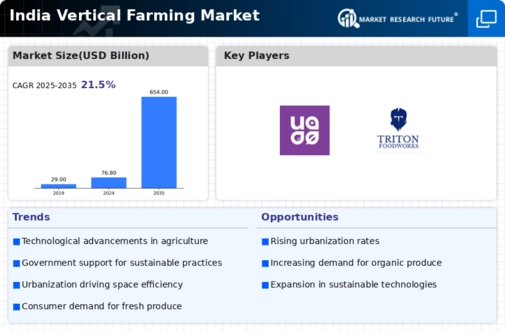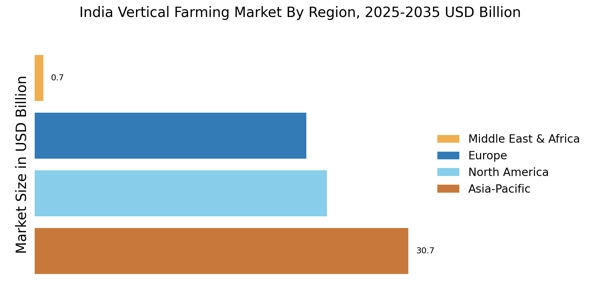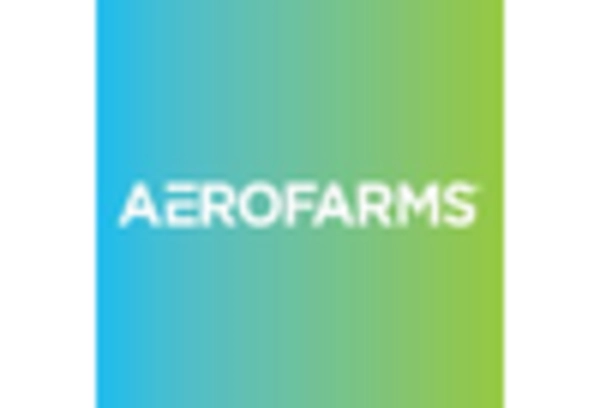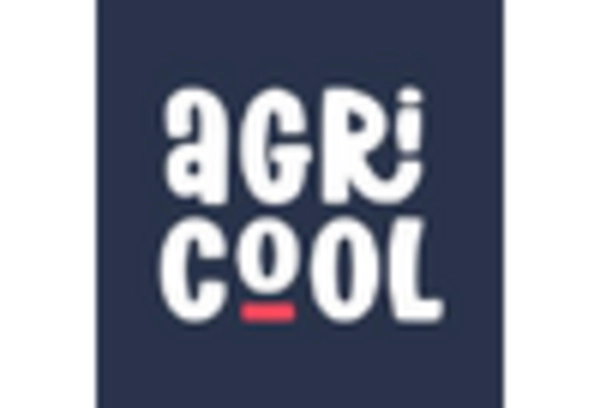Government Initiatives and Support
The India Vertical Farming Market is bolstered by various government initiatives aimed at promoting sustainable agriculture. The government has introduced policies that encourage investment in vertical farming technologies and infrastructure. Financial incentives, subsidies, and grants are being provided to startups and established businesses in the vertical farming sector. As of 2025, the government aims to increase the contribution of vertical farming to the national food supply, thereby enhancing food security. These initiatives not only support farmers but also stimulate economic growth in the agricultural sector. The proactive stance of the government indicates a commitment to fostering innovation and sustainability within the India Vertical Farming Market.
Urbanization and Space Limitations
Rapid urbanization in India is a significant driver for the India Vertical Farming Market. With over 34% of the population residing in urban areas as of 2025, the demand for space-efficient agricultural solutions is paramount. Vertical farming offers a viable alternative to traditional farming, particularly in densely populated cities where land is scarce. This method allows for the cultivation of crops in multi-layered systems, maximizing yield per square foot. Furthermore, urban vertical farms can reduce transportation costs and carbon footprints by providing fresh produce closer to consumers. The increasing number of urban dwellers is likely to propel the vertical farming sector, as it addresses both food security and environmental sustainability challenges faced by urban populations.
Technological Innovations in Agriculture
The India Vertical Farming Market is experiencing a surge in technological innovations that enhance agricultural productivity. Advanced hydroponics, aeroponics, and aquaponics systems are being integrated into vertical farms, allowing for year-round crop production. These technologies not only optimize space but also reduce water usage by up to 90% compared to traditional farming methods. The adoption of smart farming technologies, such as IoT sensors and AI-driven analytics, is further streamlining operations and improving yield quality. As of 2025, the market is projected to grow at a compound annual growth rate (CAGR) of approximately 24%, driven by these technological advancements. This trend indicates a shift towards more efficient and sustainable farming practices, positioning the India Vertical Farming Market as a key player in the future of agriculture.
Climate Change and Environmental Concerns
The impact of climate change poses a considerable challenge to traditional agriculture, thereby driving interest in the India Vertical Farming Market. Vertical farming systems are designed to be resilient against climate variability, utilizing controlled environments to mitigate the effects of adverse weather conditions. This method significantly reduces the reliance on arable land and minimizes water usage, addressing critical environmental concerns. As climate-related issues become more pronounced, the demand for sustainable agricultural practices is expected to rise. The India Vertical Farming Market is well-positioned to capitalize on this trend, offering solutions that not only enhance food production but also contribute to environmental conservation efforts.
Rising Consumer Awareness and Demand for Fresh Produce
There is a growing consumer awareness regarding health and nutrition, which is significantly influencing the India Vertical Farming Market. As consumers increasingly seek fresh, organic, and locally sourced produce, vertical farming emerges as a solution that meets these demands. The ability to grow crops without pesticides and with minimal environmental impact appeals to health-conscious consumers. Market data suggests that the demand for organic produce is expected to rise by 20% annually, further driving the vertical farming sector. This shift in consumer preferences is likely to encourage more investments in vertical farming, as businesses strive to align their offerings with the evolving market landscape.


















Leave a Comment